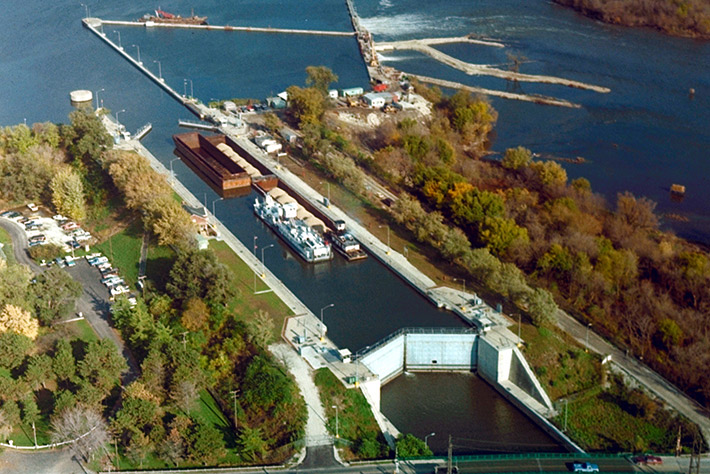Prevention
Identifying and closing potential pathways for invasive carp introduction or spread are a key component of the Invasive Carp Coordinating Committee’s (ICRCC) prevention strategy. The formation of the ICRCC initially brought together the agencies potentially affected by the expansion of invasive carp into new waterway systems; support for electric barrier maintenance within the Chicago Area Waterway System, known as the CAWS, was a key focal point. This scope has since evolved from a focus on the CAWS to include other potential pathways for invasive carp introduction, including secondary pathways as indicated in the Great Lakes and Mississippi River Interbasin Study report.
The Committee is undertaking several strategic prevention actions to address potential pathways for invasive carp to the Great Lakes.
Operate and Maintain Current Barrier System in the CAWs
The primary permanent tool for preventing movement of invasive carp from the Mississippi River watershed into the Great Lakes is the U.S. Army Corps of Engineers Electric Dispersal Barrier System located in the CAWs. The U.S. Army Corps of Engineers has operated electric barriers in the Chicago Sanitary and Ship Canal since 2002.

Aerial view of Brandon Road Lock and Dam in Joliet Illinois. Photo courtesy of the U.S. Army Corp of Engineers.
Brandon Road Interbasin Project
This project involves structural and non-structural measures to prevent the upstream movement of invasive carp and other aquatic invasive species in the vicinity of the Brandon Road Lock and Dam near Joliet, Will County, Illinois.
Killbuck Creek Pathway
The Little Killbuck Creek in Ohio was identified as a medium risk pathway from the Mississippi River basin to the Great Lakes basin. The Ohio Department of Natural Resources, U.S. Army Corps of Engineers, Summit County Metro Parks and other partners are constructing physical barriers to separate these two basins and reduce the risk for this potential pathway.
Alternate Pathway Surveillance
Federal, state and provincial agencies are leading efforts to control the transport and sale of invasive carp and other invasive species. The Illinois Department of Natural Resources Invasive Species Unit was created in 2012 as a special law enforcement component to support the invasive carp control effort. The Invasive Species Unit consists of Conservation Police Officers who are dedicated to searching for illegal activities within the commercial fishing, aquaculture, transportation, bait, pet, aquarium and live fish market industries.
Success Stories
Eagle Marsh Pathway Closure
Construction of a 1.7-mile-long berm at Eagle Marsh Nature Preserve in Fort Wayne, Indiana was completed in 2016. The wetland was identified as a significant pathway for potential migration of invasive carp to the Maumee River, and from there to Lake Erie. The project was completed with support from many agencies, including Little Rivers Wetland Project, the Natural Resources Conservation Service, the Indiana Department of Natural Resources, U.S. Environmental Protection Agency, U.S. Geological Survey and U.S. Fish and Wildlife Service.
Read about the Eagle Marsh Pathway Closure Project »
Ohio and Erie Canal Aquatic Nuisance Species Project
Identified as a medium-risk connection between the Mississippi River and Great Lakes basins, the Ohio-Erie Canal closure project was completed in May of 2020. The project was led by the U.S. Army Corps of Engineers with support from the ICRCC, the Ohio Department of Natural Resources and Summit County Metro Parks.
Technology Development
The ICRCC continues to use research and new technologies to develop additional barrier systems and strengthen existing systems.
Acoustic Deterrents
ICRCC partners are investigating the effectiveness of underwater sound as a deterrent technique to discourage the movement of invasive carp while allowing the passage of native fish and shipping to continue.
In 2019, a bioacoustic fish fence was installed at Lake Barkley lock and dam as part of a study to determine its effectiveness in deterring invasive carp in a field setting.
Learn more about the bioacoustic fish fence (PDF) »
U.S. Geological Survey is leading the development, deployment and evaluation of an underwater acoustic deterrent project at Mississippi River lock and dam 19 in Keokuk, Iowa.
Learn more about the acoustic deterrent project at lock and dam 19 »
Carbon Dioxide
CO2 is being investigated as a potential deterrent to invasive carp. Several studies have demonstrated that invasive carp and other fish are repelled from areas with elevated CO2 concentrations. This avoidance mechanism could be useful for management agencies to restrict movement through key pinch-points and better control invasive carp's range expansion towards the Great Lakes and other large river basins.

